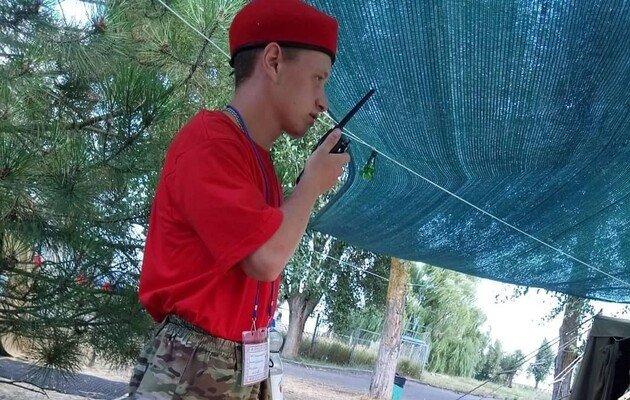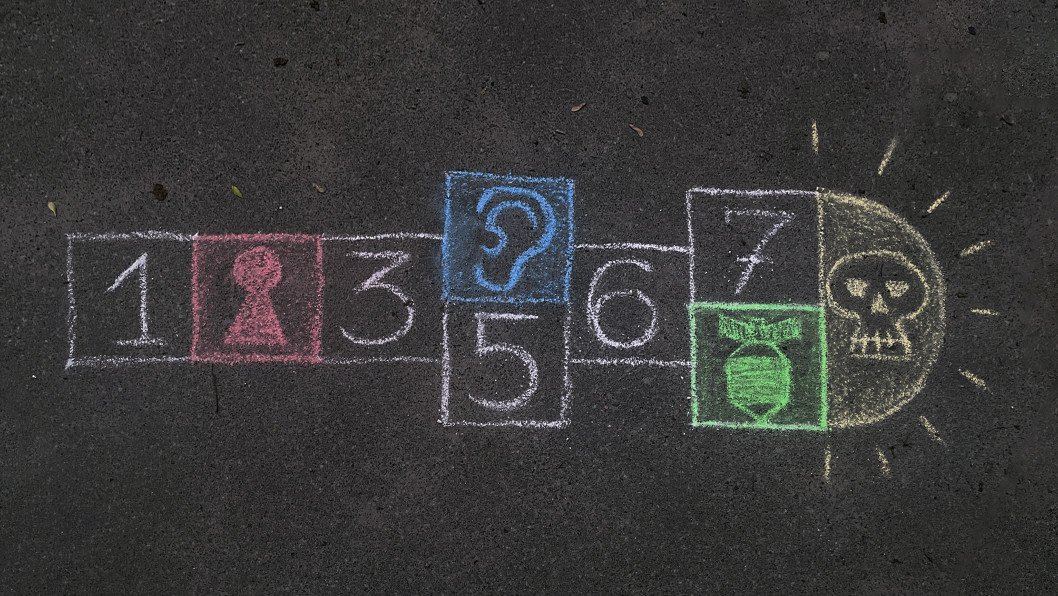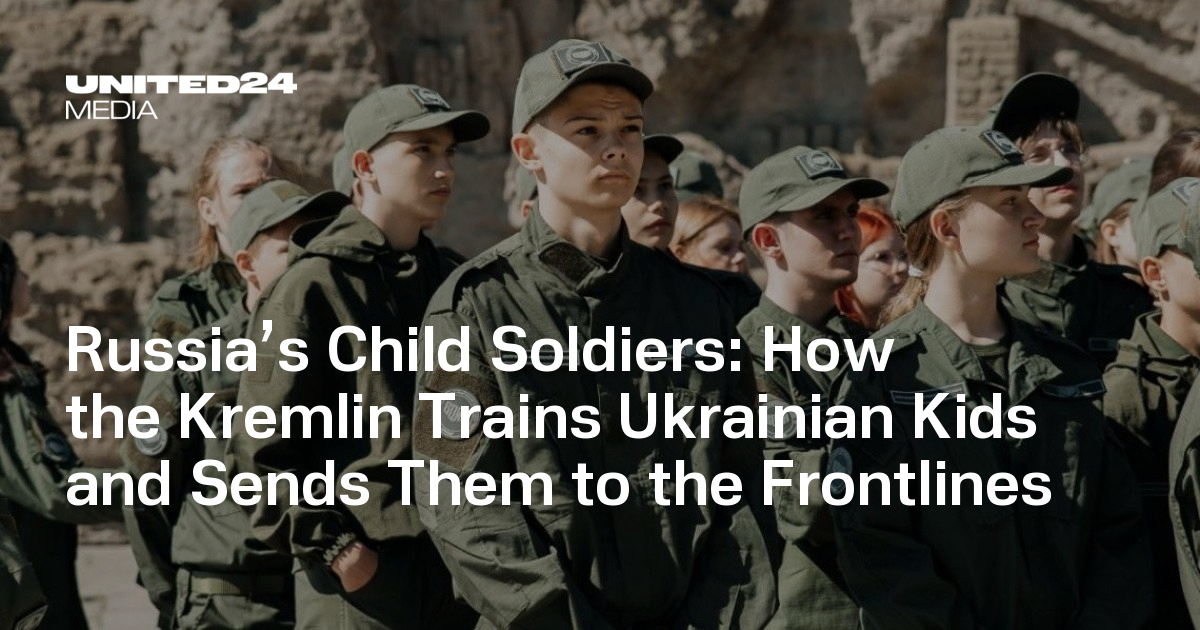Russia has abducted thousands of Ukrainian children, stripping them of their identities, indoctrinating them, and transferring them to Russia, Belarus, or occupied Ukrainian territories. There, many of these kids are trained and deployed to Ukraine’s frontlines as soldiers in the Russian army.
Updated Jul 07, 2025 17:13
13 min read
Authors
Ukraine has documented over 19,500 such cases since Russia’s full-scale war started. Official figures from Bring Kids Back UA say that only around 1,366 children had been returned to Ukrainian-controlled areas as of July 2025. Experts, including Dr Andreas Umland, an analyst at the Swedish Institute of International Affairs, note that the real number is suspected to be higher.
Reports reveal that many of these children face dire circumstances: they are placed for adoption, sent to “recreation camps,” military schools, orphanages, or even psychiatric institutions. Vulnerable and already facing the challenges of growing up amid war, older children are systematically trained to fight against their own homeland.
This article draws on the June 16, 2025, GLOBSEC report Stolen Generation: A Systematic Violation of Ukraine’s Future, which exposes the vast scale and complex mechanisms behind the Kremlin’s efforts to indoctrinate abducted Ukrainian children, stripping them of their identity and raising them to serve the Russian agenda.

A boy walks past an advertising billboard with a poster that reads “Defend Donbas” calling to serve in the self-proclaimed People Republic of Donetsk army, in Donetsk on November 15, 2018. (Source: Getty Images)
The forcible deportation of Ukraine’s children to occupied and Russian territories
The GLOBSEC report presents information showcasing that many children were moved to Russian territories under the guise of vacation, education, or medical care. Some were placed in camps posing as integration programs, others were adopted into Russian families, stripped of their identities, and reissued new documents. In Russian schools, they’re banned from speaking Ukrainian, exposed to propaganda, and often recruited into the Youth Army.
This policy dates back to 2014, after Russia occupied Crimea and parts of Donetsk and Luhansk regions, but has intensified. Many of the children taken were not orphans, despite Russian claims. Most had living parents or relatives. Some were institutionalized, others were seized after parents were detained or separated.

This photo shows young members of a military-patriotic club walking in front of the Donetsk Arena in temporarily occupied Donetsk, Ukraine, March 30, 2016. (Source: Getty Images)
Anatolii’s story is one of many such stories that fortunately ended with Save Ukraine being able to bring him back.
At 17, he was taken straight from school by Russian forces. A week before his 18th birthday, Anatolii was handed a conscription notice from the Russian army—with no real choice but to serve.
An orphan since age eight, Anatolii stayed behind in a southern Ukrainian town after his brother fled.
He became a target after he and his brother found two boxes of ammunition in a forest and threw them away. FSB agents later detained and beat him, demanding the weapons and names of Ukrainian soldiers. One day, they dragged him from the principal’s office, tied him up, put a bag over his head, and took him to be tortured.

Yunarmiya is holding a training session in temporarily occupied Donetsk, Ukraine, May 15, 2021. (Source: Anatolii Shtefan “Shtirlits” / Telegram)
“They broke my rib and shoulder joint, smashed my face, gave me lots of bruises… They said: ‘If we find anything on your phone—you won’t live.’”
At school, Anatolii was taught to shoot and handle explosives. Russians offered him trips to military camps, but he kept refusing.
In a documentary released by FRONTLINE , Volodymyr Sahaydak, director of a children’s home in Kherson, recalled Russian agents entering his facility with rifles in October of 2022 and removing orphaned children without explanation.
“I asked where they were taking the children,” he said. “They said, ‘Well, it’s not your business.’ I said that it was my business. Of course, I was threatened. Then I found out that they were taken to Crimea.”

Yunarmiya Cadets in the temporarily occupied part of the Zaporizhzhia region, Ukraine. (Source: Yunarmiya Zaporizhzhia region / VKontakte)
Indoctrination and military training
In Russian-occupied parts of Ukraine, the Kremlin is waging a long-term campaign to erase Ukrainian identity and reshape the next generation into loyal subjects of the Russian state. Central to this effort is the militarization of children through schools, propaganda, and paramilitary training.
In classrooms, Ukrainian curricula are being replaced with Russian textbooks. The language, culture, and history of Ukraine are banned or distorted. Weekly indoctrination sessions known as “Conversations About the Important” push pro-Kremlin narratives and glorify military service. Children are taught to view Ukraine and the West as enemies.

A militaristic simulation game “Zarnitsa 2.0” was held in Shakhtarsk, to which children from temporarily occupied Amvrosiivka, Chystiakove and Snizhne in the Donetsk region were taken, April, 2025. (Source: Yellow Ribbon / Telegram)
Since 2024, all Russian schools—including those in occupied Ukrainian territories—have been required to establish youth army or cadet classes starting from the fifth grade, the GLOBSEC research reported. Nearly 30 million children are now receiving or have already undergone formal training in combat and lethal skills.
This large-scale militarization of education, which began in 2017, aims to condition children for war. Around 20% are funneled into advanced training programs linked to future service in the FSB, the Internal Affairs Ministry, or other Russian elite military units.
Recruitment into these programs doesn’t focus on academic performance or discipline. Instead, students with aggressive behavior, bullying records, or emotional instability are often targeted, pointing to a disturbing strategy to raise a generation predisposed to violence and deeply indoctrinated with hostility toward NATO and the United States.

Member of the Youth Army is kissing the Victory Banner, the banner raised by Red Army soldiers on the Reichstag building in Berlin on 1 May 1945, kneeling on one knee. (Source: Head of the Board of the Ukrainian Human Rights Protection Center Liudmyla Denisova/Facebook)
The Youth Army system
In 2016, Russia’s Defense Ministry launched a youth “military-patriotic” organization called Yunarmiya, or in English, Young Army. In reality, it’s a militarized movement that instills the ideology of Russian aggression and grooms future soldiers for the occupying regime.
Children as young as eight are enrolled. They’re made to swear an oath of loyalty to Russia, promise to “defend its interests,” and embrace “great patriotism.” After that, they undergo firearms and tactical training, learn to operate drones, and more.
Ashley Jordana, Hala Systems’ Director of Law, Policy and Human Rights, said Hala’s assessment, based on geolocation data from mobile phones traced to Yunarmiya bases and testimonies from survivors, suggests cadets are roused daily at 6 am. After a canteen breakfast of eggs and oatmeal, they attend classes in firearms assembly, mine clearance, and military tactics.

Youth Army members in occupied Donetsk, Ukraine. (Source: “Youth Army of the DPR”/VK)
In the afternoons, they are often deployed to the field to apply those skills in simulated combat. One satellite image reviewed by The Globe appears to show trenches dug on the grounds of a Yunarmiya base in occupied Melitopol.
If states knew how much time and effort and resources Russia was putting into mobilizing and training a new generation of what are now children as eventual soldiers, I think that there would be a lot more concern.
Ashley Jordana
Hala Systems’ Director of Law, Policy and Human Rights
This system is not new. In Crimea, occupied since 2014, Russian authorities dismantled Ukrainian education and launched programs like The Train of Hope to assimilate children. The programme is a Russian state-run initiative launched in occupied Crimea that facilitates the adoption of Ukrainian children by Russian families. Monuments to Russian weapons designers were erected on school grounds, and a 2014 doctrine officially linked education to military preparation.
The model has since been replicated in newly occupied parts of regions like Zaporizhzhia and Kherson. Children are recruited into initiatives that reward allegiance to the Russian state and strip away traces of their Ukrainian roots. From “Clean Streets” campaigns to pro-war holiday mail drives, these activities aim to normalize Russian occupation and encourage ideological loyalty.

A cadet class at School No. 2 in Syvash, temporarily occupied Kherson region. (Source: Russian media)
Children forced to fight against Ukraine
Some of the children indoctrinated after 2014 are now dying on the battlefield, celebrated as heroes in Russian propaganda. One such case is 16-year-old Illia Moskvitin, a Youth Army member from occupied Donetsk, who was killed by a landmine in 2022. Others, like Ivan Shifman and Dmytro Kotov, joined Russian forces after years of ideological grooming.
Olena Glushchenko, psychotherapist and expert in demilitarisation and psychological rehabilitation of children in Ukraine, warned that after prolonged exposure—two or three years or more—it becomes increasingly difficult to reverse the effects. The aim is not just compliance, but transformation: to raise a generation of Ukrainians who no longer identify as such.
The indoctrination of Ukrainian children by Russian authorities has a sinister goal—it aims to prepare them to fight against their own homeland. Through forced involvement in military formations, combat training, and the cultivation of a culture of aggression, children are stripped of their childhood and identity. In many cases, it costs them their lives.

Dmytro Kotov, born May 3, 1998 – died March 24, 2022. (Source: inlens24.ru)
Dmytro Kotov
One such case is Dmytro Kotov. In 2015, he graduated from Gymnasium №6 in Dzhankoi, temporarily occupied Crimea. Russia later sent him to Yunarmiya, according to open-source data.
After completing his studies at the Sevastopol State Technical University, Kotov signed a contract with the Russian military and served aboard the large landing ship Novocherkassk, part of the 197th Brigade of the Black Sea Fleet.
Dmytro died on March 24, 2022, while participating in Russia’s war against Ukraine.

Illia Moskvitin, born June 16, 2008 – died March 18, 2024. (Source: Yunarmia social media)
Illia Moskvitin
Illia Moskvitin was also a member of the Yunarmiya unit operating in the Russian-occupied Donetsk region.
Illia died on April 14, 2022, before even reaching the age of 16, after stepping on a Lepestok anti-personnel mine, according to materials published by the Yunarmiya organization.

An alleged photo of Ivan Shifman, born September 22, 2001 – died April 14, 2022. (Source: Head of the Board of the Ukrainian Human Rights Protection Center Liudmyla Denisova/Telegram)
Ivan Shifman
Ivan Shifman, a student at School №1 in the city of Kalmiuske in the Donetsk region, joined Yunarmiya in 2019. After turning 18, he enlisted in the so-called “People’s Militia of the Donetsk People’s Republic” and began serving in Russia’s 1st Separate Guards Motor Rifle Brigade.
Following the start of Russia’s full-scale invasion of Ukraine, Ivan took part in combat operations in several towns across the Donetsk region, including Starohnativka, Hranitne, Malyi Yanisol, Zaitseve, and Rozivka.
Ivan was killed in action near the village of Novobakhmutivka along the front line in Donetsk on April 14, 2022—the same day as Illia.

A map of institutions across Russian-occupied Ukrainian territories where abducted children are held, according to SBU intelligence. Facilities range from so-called “health resorts” and orphanages to military schools—part of Russia’s systematic effort to erase Ukrainian identity and sever children from their families and homeland.
Who receives the abducted children?
Using data provided by Ukraine’s Security Service (SBU) and the Bring Kids Back UA team, UNITED24 Media compiled maps in June 2025, showing the locations where the children are being taken in both Russia and the occupied territories.
In May 2022, Moscow issued Decrees 183 and 187, fast-tracking Russian citizenship for Ukrainian children—reducing the process from up to five years to just 90 days. By December, Putin signed another decree allowing caregivers in occupied territories to revoke a child’s Ukrainian citizenship.

A map of institutions across Russian-occupied Ukrainian territories where abducted children are held, according to SBU intelligence. Facilities range from so-called “health resorts” and orphanages to military schools—part of Russia’s systematic effort to erase Ukrainian identity and sever children from their families and homeland.
Within months of the full-scale invasion, Russia had formalized an adoption system. A federal registry of “suitable” Russian families was established, and by October 2022—just a week after Russia declared the “annexation” of Donetsk, Luhansk, Kherson, and Zaporizhzhia regions—the first profiles of “evacuated” Ukrainian children appeared. Between October and November, 263 profiles were added, half of them classified as lacking parental care by court order.
In January 2024, a new decree gave the Russian president personal authority to grant Russian citizenship to Ukrainian orphans and children without guardians. Legal experts in Kyiv confirmed that this marked the completion of Russia’s first phase of child “passportization.”
Many of the children were then adopted or placed in Russian boarding schools. Dozens of adoptive parents were teachers, military personnel—including veterans of the Chechen wars—or individuals linked to cultural and religious institutions, according to the Regional Center for Human Rights.

Russian leader Vladimir Putin meets with Commissioner for Children’s Rights Maria Lvova-Belova at the Kremlin in Moscow on March 9, 2022. (Source: Getty Images)
What needs to be done to prevent it
The evidence gathered in this article barely touches the surface of this issue, but it shows how Russia’s child abductions are a systemic state policy.
The International Criminal Court issued arrest warrants in March 2023 for Russian leader Vladimir Putin and Presidential Commissioner for Children’s Rights Maria Lvova-Belova for their roles in the deportations, an act that constitutes a war crime under international law.
Both are suspected of committing the war crime of unlawfully deporting children from occupied Ukrainian territories to Russia—an operation the court says has been underway since at least February 24, 2022.
A historic moment in international law unfolded in Strasbourg on June 25, 2025, as Ukrainian President Volodymyr Zelenskyy and Council of Europe Secretary General Alain Berset formally launched the Special Tribunal for the Crime of Aggression Against Ukraine, established in response to Russia’s full-scale invasion.

For Ukraine, the return of all deported children is a non-negotiable condition for any future peace deal with Russia.
A bipartisan resolution condemning Russia’s abduction and forcible transfer of Ukrainian children was introduced on June 30, 2025, by the Representatives Gregory W. Meeks, Ranking Member of the House Foreign Affairs Committee, and Michael McCaul, Chairman Emeritus. The resolution calls for the immediate return of all abducted children as a prerequisite for any future peace agreement.
“Putin is a war criminal and, under his watch, the Russian military has cruelly abducted and illegally deported tens of thousands of Ukrainian children from their homeland
Gregory W. Meeks
Representative
“These atrocities are not isolated incidents,” said Meeks. “They are the direct result of Putin’s war of choice. The United States has a responsibility to condemn these unconscionable acts by Russia and to demand the immediate return of each and every one of the children Russia has taken.”

The training of the Steppen Wolves, so-called “military patriotic club” for children living in the temporarily occupied city of Ilovaisk, Donetsk region, Ukraine, July 9, 2017. (Source: Getty Images)
In order to bring kids back, it is essential to intensify international pressure on the Russian authorities by imposing additional sanctions on individuals and organizations involved in the militarization of children in the temporarily occupied territories. In addition, global monitoring mechanisms should be established to track and prevent such violations.
Russia’s strategy of abduction, identity erasure, and militarization poses one of the most serious threats to Ukraine’s future. By targeting children, it isn’t just waging war—it’s attempting to rewrite an entire nation.
Related articles

